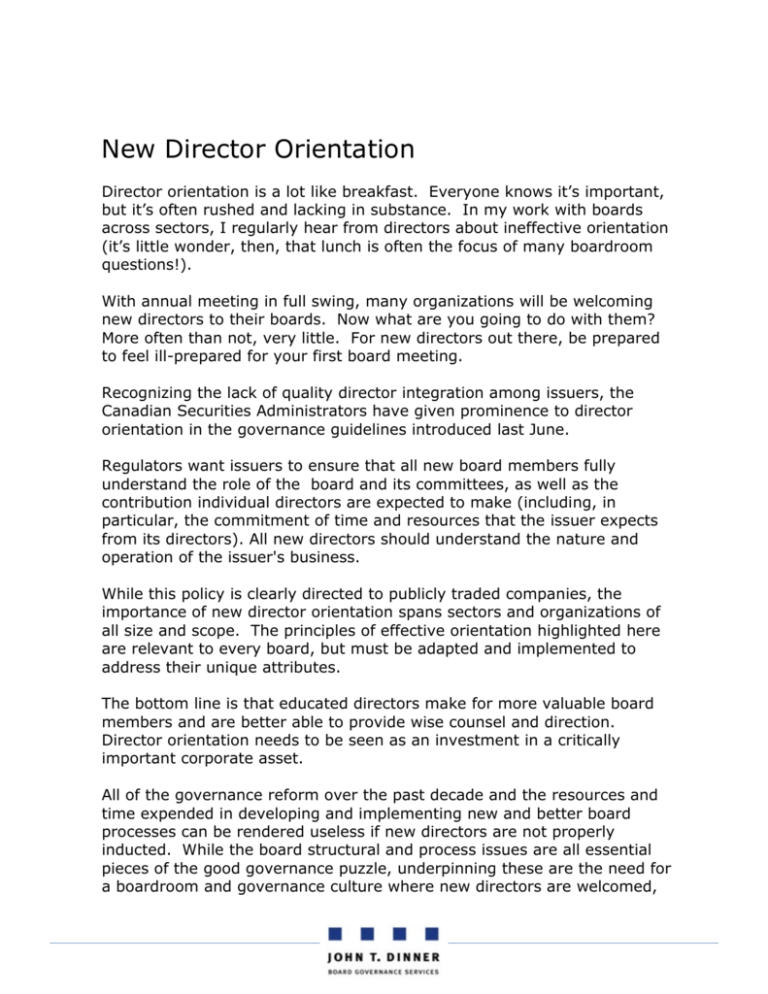New Director Orientation - Mississauga Halton LHIN
advertisement

New Director Orientation Director orientation is a lot like breakfast. Everyone knows it’s important, but it’s often rushed and lacking in substance. In my work with boards across sectors, I regularly hear from directors about ineffective orientation (it’s little wonder, then, that lunch is often the focus of many boardroom questions!). With annual meeting in full swing, many organizations will be welcoming new directors to their boards. Now what are you going to do with them? More often than not, very little. For new directors out there, be prepared to feel ill-prepared for your first board meeting. Recognizing the lack of quality director integration among issuers, the Canadian Securities Administrators have given prominence to director orientation in the governance guidelines introduced last June. Regulators want issuers to ensure that all new board members fully understand the role of the board and its committees, as well as the contribution individual directors are expected to make (including, in particular, the commitment of time and resources that the issuer expects from its directors). All new directors should understand the nature and operation of the issuer's business. While this policy is clearly directed to publicly traded companies, the importance of new director orientation spans sectors and organizations of all size and scope. The principles of effective orientation highlighted here are relevant to every board, but must be adapted and implemented to address their unique attributes. The bottom line is that educated directors make for more valuable board members and are better able to provide wise counsel and direction. Director orientation needs to be seen as an investment in a critically important corporate asset. All of the governance reform over the past decade and the resources and time expended in developing and implementing new and better board processes can be rendered useless if new directors are not properly inducted. While the board structural and process issues are all essential pieces of the good governance puzzle, underpinning these are the need for a boardroom and governance culture where new directors are welcomed, oriented, valued, and respected. Developing new board members to where they become valued contributors is a significant challenge requiring a strategically designed process to ensure individual success in the boardroom. But where to start? Equipping the new recruit with a basic understanding of how your organization governs itself and its business focus are foundational. While many boards fall into the trap of replicating management skills and experience on the board, director independence guidelines mean that, increasingly, new directors will be recruited from other sectors with little or no industry or boardroom experience. It’s hard to contribute to discussion and decision-making if you don’t know the business. So, you can initiative the process by providing new directors with external consultant reports, books, trade journals and websites, and other useful resources. While general information is valuable and essential, director orientation must be tailored to the new board member’s specific needs and the board’s requirements. They must reflect that director, on that board, in that company, and in that industry. Directors need to be briefed on the organization’s core functions and business drivers, and industry developments. New directors should be provided insights into key client relationships and the organization’s position in the industry -- its strengths and weaknesses, along with competitive threats and opportunities. One-on-one time, on-site with each member of the senior management team are essential, with additional time with the chief financial officer to make sure new directors gain comfort level with relevant financial information and accounting rules. Having the opportunity to communicate directly with those who are giving direct leadership to running the business provides invaluable insights. A new director orientation program, at a minimum, should include: a governance briefing by the Chair or President; an introduction to the company, its mission, and values by the CEO and other senior officers; stakeholder communications, accountability and disclosure documents access to key analysts who cover the company; financial performance of the company and comparative industry data; strategy and operations at the division or department level; human resources and succession planning; and, the legal and ethical environment. In preparation for site visits and management meetings, pre-read and background materials should be provided to new directors well in advance so they are prepared to ask questions that will help close knowledge gaps. The agenda should focus on the business from a strategic perspective, with plenty of time available for informal exchanges of information and questions, as opposed to formal, one-sided presentations. An effective orientation program should also introduce the “softer” side of the board: its culture, the relationship with management, group dynamics and other governance “informalities”. The can be achieved through meetings with the board chair and more senior directors who can help establish rapport and set expectations around director performance. One way to tackle this side of director orientation is for established board members to mentor new recruits through easily accessible off-line advice. Organizations also need to invest in building the board team through planned social interaction. This can be easily included as part of off-site meetings where significant company operations are located. These occasions can be used for business unit reviews, as well as providing more concentrated time for board members to get to know their board colleagues. Effective director orientation clearly doesn’t just happen. Organizations need to develop the means to proactively identify director developmental needs. Here, the board chair or governance committee has a critical role to play in making sure that the potential new directors bring to the boardroom is leveraged as fully as possible. Just like other organizational assets, there needs to be a planned and concerted effort to develop new directors to achieve good governance and board excellence.







